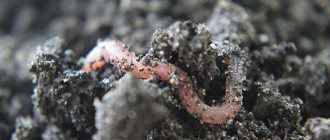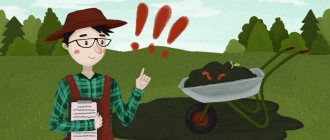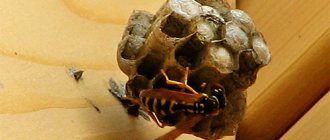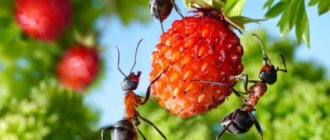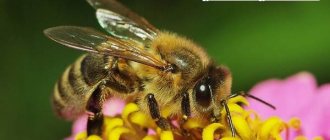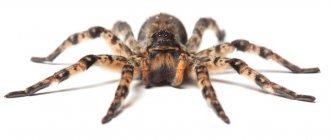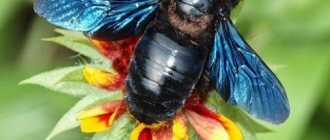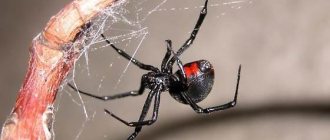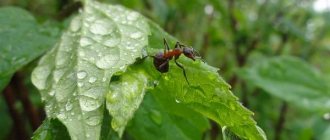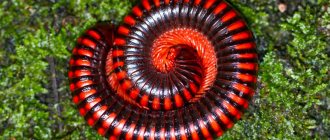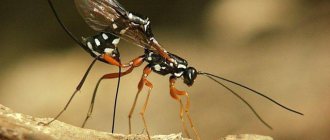Home — Zoology — Worms — Reproduction of earthworms
Well-known earthworms are not only one of the links in the food chain in nature. These are also mini-factories for processing organic residues that fall on the ground into a nutritious substance called humus. Thanks to them, the soil in which they live becomes richer and is able to breathe. The underground passages that the worm makes as it moves below the surface allow air to penetrate to the roots of the plants.
Main method of reproduction
But, nevertheless, in order for a worm to reproduce, as a rule, it usually needs a second individual, i.e. pair. The reproductive organs of worms are located on the abdomen near the head.
One of the key roles in the exchange of germ cells is played by a small thickening on the worm’s body called the girdle. During mating, these thickenings are located nearby, and a dense mucous liquid appears that covers the bodies of the worms like a coupling.
The liquid in which the sex cells are located enters this coupling through small holes, and an exchange occurs. After mating, the individuals disperse. The liquid containing the germ cells is stored in the girdle for a couple of days.
This time is enough for the seminal fluid to mature. Next, mucus similar to a cocoon begins to secrete from the girdle. The worm removes it from its own body, slipping out of it. The belt remains in the soil, and the eggs end up in the mucus.
Process of mating and reproduction
This is the last stage of fertilization. From the testicles remaining in the cocoon, tiny rainflies subsequently appear, completely similar to adult individuals. Such cocoons are formed approximately once every seven days. They are similar in appearance to lemons, but much smaller, about 3 mm.
The color of the cocoons is yellowish, and with mature eggs it is brown. There are few eggs in such an earthworm cocoon, from two to twenty. Their development lasts approximately twenty days.
Young worms are very thin, like threads, about 5 mm long, but they grow quite quickly, feed on their own and are soon ready.
Head-tailed or tail-headed?
If you don’t know the body structure of an earthworm, you can very easily make a mistake when determining where its head is and where its tail is. Its elongated shape without any external organs allows the worm to calmly move through the earth in search of food.
Earthworms are a type of annelid worms, the very name of which indicates the characteristic structure of their body. They seem to be assembled from small rings strung on an elastic band. The segments formed by the constrictions have small bristles on the sides, with the help of which the worm moves.
Unlike many others, the earthworm does not have many such setae, for which its subclass received the name oligochaete. In each individual, closer to the head part, the body is surrounded by a thickening, which gave the name to the class - girdle . Its presence indicates the worm's ability to reproduce. This belt is part of the reproductive system of these animals.
Regenerative propagation
The worm’s ability to regenerate is also amazing. When cutting one individual, each half can grow back the missing part. But it is worth noting that the rear tip grows quite quickly, but the head part grows less frequently and takes longer.
As a result of these abilities, raincoats have spread almost throughout the globe, making the soil fertile while providing food for many animals.
Their unpretentiousness in food and excellent adaptability to living conditions allow them to reproduce well.
Population increase
Currently, gardeners and people who practice organic farming practice many ways to improve soil fertility.
One of them is the reproduction of invertebrates. When performing this task, it is customary to add various organic matter to the soil, as well as mulch. The surface layers are treated with humus, fallen leaves, manure, compost and other similar substances. Some gardeners try to breed animals themselves. This action is not considered too difficult, so even beginners can do it. The main thing is to ensure optimal access to food , adequate humidity, protection from sunlight and plenty of free space. Successful breeding of a worm farm is possible in early spring or early summer, when the air temperature reaches optimal levels. During this period, the worms have time to mate and get stronger before the coming winter.
Worm breeding methods
For a vermifarm, the main thing is to choose a closed space in order to protect pets from predatory pests and harmful environmental factors (sun, rain, wind), and at the same time from migration from their place of residence. And the vermifarmer chooses the method of propagation of the earthworm according to his own taste, taking into account future plans.
Home mini vermifarm
If desired, worms are kept in an apartment or house, using any container, even a mayonnaise bucket. The small farm recycles the family's food waste and in return provides fertilizer for houseplants.
Container method
Mobile and cheap medium-sized boxes are popular among werm farmers. These make it easier to transport pets from place to place, collect vermicompost, and monitor parameters.
Rack method
If you allocate a room for your pets (basement, barn, warm veranda), then you can compactly place at least as many worms in a small area, but in 2-4 tiers. Racks are bulky and not portable, but they make it possible to expand production.
Burt method of breeding
If there is a plot of land, this method does not limit the breeder in the size of the farm. Breeding worms in piles is beneficial for producers of agricultural and food products, since their own production waste will be used to feed pets. By the way, in spacious conditions worms reproduce faster than in boxes.
Arrangement of the worm house
If you want to start breeding earthworms at home, you need to equip a spacious worm barn in advance. The structure should become a comfortable home for the spineless, where they can live, eat and perform their biological duties.
A wooden box, a trough, an old bathtub and other similar structures can be used as a container. Experienced gardeners recommend placing high-quality open compost in the container. However, the ground must be protected with netting to prevent mass consumption of eukaryotes by birds and other natural enemies.
Proper worm care involves preparing suitable fertile soil. About 40 centimeters of compost should be placed at the bottom of the box, after which it should be filled with warm water. Next, you should create a straw bedding and wait a few days until the substances are completely absorbed. After completing these steps, you can put the worm into operation.
Finding the first group of worms to move is not difficult. It is enough to go to your own garden or vegetable garden and dig up a small layer of soil. Individuals living in the upper layers tolerate movement into the worm nest better than all others. Invertebrates are also sold in specialized gardening stores.
Settlement is carried out in several stages. The first thing a gardener needs to do is dig a small hole and then place a bucket of worms there. After this, the animals are covered with straw or burlap. In a week you will be able to notice the first results of the worms taking root.
To prevent the death of the colony, it is necessary to regularly monitor them. If the creatures demonstrate an active lifestyle, it means that they have managed to settle down normally , and everything is fine with them.
To improve adaptation to the new environment, the worms need to be fed only after 3-4 weeks. However, the heated liquid should be placed in the worm chamber at least twice a week.
Nervous system
The nervous system of the earthworm (Fig. 52) is of the nodal type, consisting of a peripharyngeal nerve ring and an ventral nerve cord.
The ventral nerve cord contains giant nerve fibers that, in response to signals, cause the worm's muscles to contract. Such a nervous system ensures the coordinated work of the muscle layers associated with the digging, locomotor, feeding and sexual activity of the earthworm.
Medvedka
Mole crickets are the main enemies of vegetable beds, found in many regions. Adult insects and their larvae damage plants.
Females are extremely fertile. Each of them is capable of laying up to 350 eggs per season. For laying, insects choose moist areas of soil. Embryos develop only at 100% humidity. Irrigated beds for this reason attract the largest number of insects.
Pests snack on underground parts of plants (damaged stems are easily removed from the ground). Most often, mole crickets love potato, cabbage and tomato beds. They feed on the roots and tubers of cultivated plants.
Preventive control measures include deep digging and setting up traps (fresh manure is often used, which attracts insects). Before planting seedlings, rhizomes should be treated with Aktara solution (1.5 grams per liter of water). "Medvedtox" is applied directly into planting holes and furrows.
Subtleties of proper care
To extend the lifespan of earthworms, they need to be properly cared for, providing comfortable conditions for development and reproductive functions. The key rules of care are to ensure a comfortable temperature, shade and stable access to food.
Professional gardeners recommend enriching compost manure with sand or crushed eggshells. Dry food is added to the soil approximately once every two weeks, but it is important to take precautions here so as not to overfeed the worms.
If you want to start breeding creatures at home, you need to remember that worms process almost everything that catches their eye. The main thing is that the products are small in size, because invertebrates do not have teeth.
Before replenishing the worm house with new food, you need to make sure that the previous organic matter is completely destroyed. If this is not the case, the animals will suffer from oversaturation and die. Leaving organic compounds in the compost will negatively impact the acidity levels, leading to deadly conditions. In addition, excess food supply contributes to the development of pests such as mites.
Caring for worms is relatively easy, but some requirements must be met. Only under such conditions will breeding a home farm bring the expected success.
Adviсe
- Worms should be protected from direct sunlight. If you notice that the worms tend to crawl away, congregating at the edge of the container, it is necessary to place a source of artificial light above the surface of the container to prevent the worms from spreading.
- If you are able to breed more worms than you need, then you can sell them to a fishing bait shop, or give them to other fishermen.
- When you are going fishing, take with you exactly as many worms as you consider necessary for that day. You can place animals in special containers that are made for this purpose and have porous sides, or use cardboard ice cream boxes filled with peat moss and have holes to allow air to enter.
Useful on the farm
Earthworms by their “profession” are natural soil looseners that optimize the soil structure and increase the level of fertility. When moving around the site, individuals make long, deep passages and holes. They stabilize air exchange through root systems and seeds. Invertebrates consume rotten grass and leaves, and dirt as food. This is a good prevention against the development of harmful insects and diseases. They saturate the soil with substances necessary for plants from the periodic table, such as:
- nitrogen,
- calcium,
- phosphorus,
- magnesium.
To read: Treatment of head lice in children: effective drugs against lice and nits
Scoops
The cutworm family includes more than a hundred species that damage beds.
The larvae of some species live underground and damage plant roots. The most common are winter cutworm, marsh cutworm, borer cutworm, and wild cutworm.
The larvae feed on the roots of tomatoes, beans, cabbage, wheat, rye, sunflower, beets, onions and garlic.
Prevention measures include installing pheromone traps and eliminating weeds near the beds. These measures reduce the number of adult butterflies, and, therefore, the number of larvae.
To combat the larvae, it is necessary to carry out deep digging of the soil and crop rotation. Karate, Fury or Decis are used as insecticides for spring spraying. In summer, Fufanon and Dursban are used. No more than two treatments are carried out per year. When planting potatoes, “Bazudin” is added to the holes.
